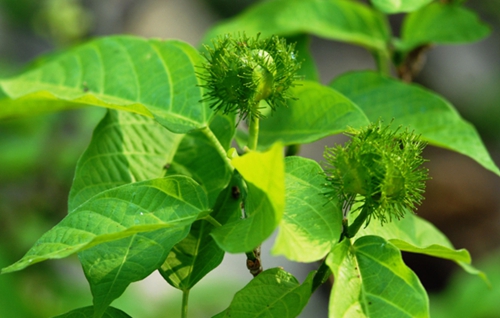The roots of Strophioblachia fimbricaly are commonly used by the ethnic Dai people in China to treat migraine, fever, and cancer. Previous phytochemical studies showed the presence of megastigmane glucosides, flavone glycosides, phenanthrenone, and phenanthropolones, and some of these compounds have been demonstrated to be antiplasmodial and cytotoxic agents.
In the search for biologically active components from S. fimbricalyx, researchers from Xishuangbanna Tropical Botanical Garden (XTBG) investigated the leaves and stems. Five new compounds, namely fimbricalyxoids A–D (1–4) and 13-O-methylfimbricalyx B (5), together with five known compounds (6–10) were isolated from the leaves and stems of Strophioblachia fimbricalyx.
Compound 1 was obtained as a white powder with a molecular formula of C20H26O3 and named fimbricalyxoid A. Compound 2 (C17H16O2 ) was named fimbricalyxoid B, and compound 3 (C17H20O4 ) and compound 4 (C17H16O5 ) as fimbricalyxoid C and D respectively. Compound 5 (C19H18O5 ) was isolated as a red powder and established as 13-O-methyl fimbricalyx B.
Five known compounds were identified to be 12-hydroxy-13-methylpodocarpa-9,11,13-trien-3-one (6), trigonostemon (7), limettin (8),5-methoxy-7-hydroxycoumarin (9),and sonderianol (10)by comparing their spectroscopic data with those in the literature.
Their structures were established by extensive spectroscopic analysis and the cytotoxic activities of all compounds against five human cancer cell lines (HL-60, SMMC-7721, A-549, MCF-7, and SW480) were evaluated using the MTS method. Fimbricalyxoid A, a cleistanthane diterpenoid, possessed a rare 3,20-oxybridge.Fimbricalyxoids C–D were the first seco-ring-A pentanorditerpenoids. Compounds 1, 6, and 7 exhibited cytotoxicity against five human tumor cell lines.
The study entitled “Diterpenoids and phenanthrenones from the leaves and stems of Strophioblachia fimbricalyx” has been published in Tetrahedron Letters.
Contact
XU Youkai
Key Laboratory of Tropical Plant Resources and Sustainable Use, Xishuangbanna Tropical Botanical Garden, Chinese Academy of Sciences, Menglun 666303, Yunnan, China
E-mail: xyk@xtbg.org.cn
Tel: 86 691 8715459

Strophioblachia fimbricaly (Image by XU Youkai) |

